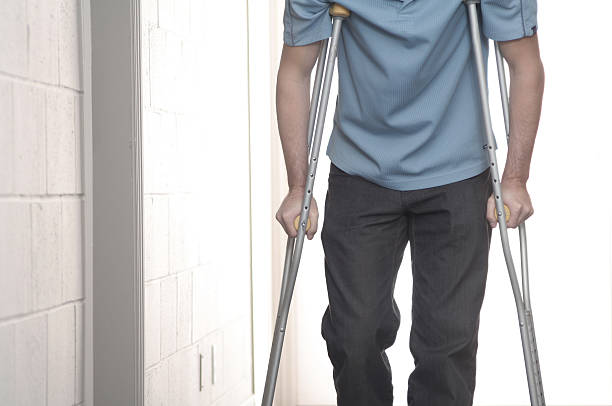According to a research published by the National Highway Traffic Safety Administration, there are more than 2.3 million motor vehicle-related injuries annually. Among these injuries, about 10 % - 28 % cause hip dislocation. A hip injury or dislocation is one of the most common, dangerous, and difficult injuries to treat. A hip dislocation occurs when the femur head, or ball at one end of your thigh bone, pops out of its socket.
Typically, a sudden forceful impact can cause serious trauma to your body that would result in an injury such as hip dislocation. The most common causes of hip dislocation, fracture, and injury are car collisions and high falls, Yet, even a simple fall on the ground may result in a hip being dislocated.
Let’s discuss hip dislocation, its common causes, symptoms, treatment, and recovery tips.
Types of Hip Dislocation
When you dislocate your hip joint, one of the two things happens to the femur; either the femoral head is pushed backward out of the socket, or forward.
Posterior Dislocation
According to the National Institute of Health (NIH), in about 90% of hip dislocation injuries, the femoral head is pushed backward out of its socket. This type of dislocation is called a posterior hip dislocation. It leaves the lower leg in an unusual position with the knee and foot rotated inward towards the middle of your body.
Anterior Dislocation
When the femoral head of your thigh bone slips out of its socket in a forward direction, that is called Anterior Dislocation. This type of dislocation will cause your leg to rotate outward, away from the middle of your body.
Anatomy of the Hip Joint
The hip is a ball-and-socket joint. The socket (or acetabulum) holds the femoral head as it moves in and out of place which makes walking possible. Without this small but crucial piece at our center, we wouldn't be able to move.
Articular cartilage, the most durable tissue in our body, protects and cushions the ball and socket joint. Not only does this clever membrane reduce friction when we move, but it also helps to keep joints lubricated with synovial fluid for top performance.
The acetabulum is the ring where your hip bone meets the pelvis, it's surrounded by strong fibrocartilage called the labrum. The labrum forms a gasket around this socket, creating stability for your joint with its tight seal to support you from any injury.
The hip is a complex joint. When it dislocates, the ligaments, labrum, and other soft tissues and muscles that keep your bones in place are often damaged too. The nerves around your hips may be injured as well.
Causes
Hip dislocations are a common injury. According to a study by NCBI (National Center for Biotechnology Information), motor vehicle accidents are the cause of about 95% of hip dislocation injuries.
In a car accident, hip dislocation usually occurs when the knee hits the dashboard. This force drives the thigh backward, causing the ball head of the femur to fall out of its socket.
The result of such a forceful impact not only causes the hip to dislocate but also results in a ripple effect that causes other fractures as well. One of such injuries, called posterior wall acetabular fracture-dislocation, happens when the head of the femur (or thighbone) strikes and breaks off from its socket in the back. It's one thing to have your hip out of joint; it's another for it to be broken too.
The benefit of wearing a seat belt is that, in the event of an auto accident, your chances of suffering from hip dislocation are greatly reduced.
Symptoms
Hip Dislocation is extremely painful, but apart from the pain, a person may experience the following symptoms:
- A leg that appears to be rotated outward or inward
- Inability to move the leg
- Loss of sensation in the foot or ankle
- A leg that seems slightly shorter than the other
As with any injury, seeking immediate medical care may help in reducing further complications.
Diagnosis
An orthopedic physician can identify the hip dislocation injury by simply examining the position of the leg.
Since hip dislocations are often accompanied by other fractures and injuries, your doctor may order imaging tests, such as x-rays or CT scans, to point out the exact position of dislocated joints, and identify any fractures in the hip bone.
Treatment
Reduction Procedure
Hip dislocation can affect blood flow to the legs and can damage the nerves as well. If there are no other injuries or fractures in your hip or leg, a doctor will probably carry out the reduction procedure as the initial treatment. A reduction procedure involves manipulating bones back into their position.
In most cases, the reduction procedure is done under anesthesia in an operating room. While in some rare instances, small bone fragments or torn soft tissues block the bone from going back to its proper position. In this case, surgery is required to remove the torn tissue and fragments in order to put the bone back into the socket.
After the reduction procedure, the doctor may request another CT scan to make sure that the hip bone is in the socket.
Complications
According to research conducted by The American Journal of Orthopedics, reduction procedures have a success rate of 68%. But there might be some complications if there are fractures in the hip bone, leg, or if there is any nerve damage. In such cases, orthopedic surgery may be required.
Recovery
It takes 2-3 months to heal after a hip dislocation. This may take even longer if the person has associated fractures as well.
Doctors recommend limiting hip movement as much as possible for several weeks after the surgery. The person may use walking aids such as crutches, canes, or walkers to assist with walking after the first few weeks of recovery. Because it reduces stress and pressure on the joint while it’s healing.
To strengthen and stabilize the joint, physical therapy is also recommended during and after the recovery period. A physiotherapist will provide a specific exercise routine to help with the recovery and healing process.
Prevention & Care
Hip dislocations are often the result of accidents. Practicing safety such as wearing a seatbelt in cars and using ladders safely can prevent this critical injury from happening. Wearing sturdy shoes and orthotics to stay balanced during high-impact sports can also help prevent hip dislocation.
Many people who have had hip replacements or surgical procedures to correct a traumatic fracture are surprised to discover they can do very little physical activity for the first six weeks after their surgery. Along with wearing a sling or cast, the body is still in a state of trauma during the crucial first few weeks after surgery.
- Be gentle on yourself and your body as the hip bone heals and stabilizes.
- A healthy diet and staying hydrated will help you feel better while recovering.
- Try to minimize sudden or drastic movement to the hip.
- Wearing clothing that is easy to get on and off can help avoid too much bending and irritation to scars.

Conclusion
Hip dislocation is a serious injury that can have severe, permanent consequences if not treated immediately. The most important thing to do in the event of hip dislocation is to get medical attention right away. With the proper recovery program, you will begin to build your strength and see the signs of recovery. Most therapists recommend incorporating exercises into your daily routine for the long run
Our mission is to help you recover and get back to life as easily as possible. Reboundwear’s adaptive clothing line is particularly designed to help those recovering from hip surgery. If you are an active adult and getting back quickly is important to you, we have got the best adaptive wear waiting for you.
Check out our post-hip surgery adaptive wear, click here.





Leave a comment
All comments are moderated before being published.
This site is protected by hCaptcha and the hCaptcha Privacy Policy and Terms of Service apply.